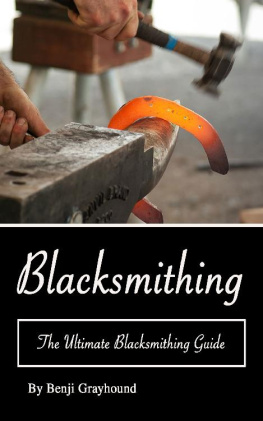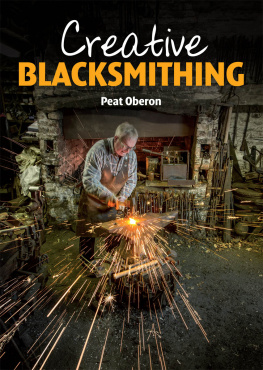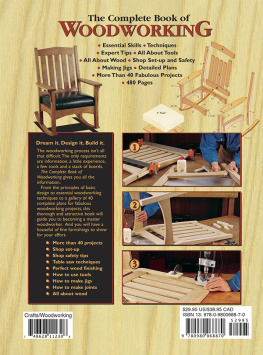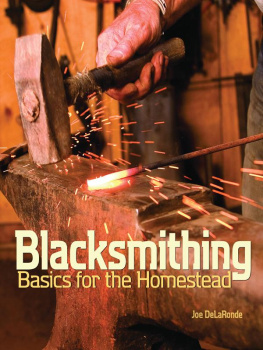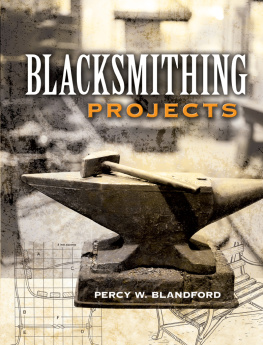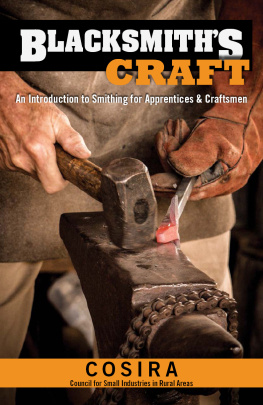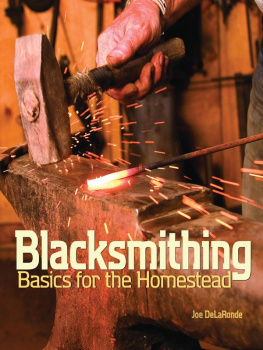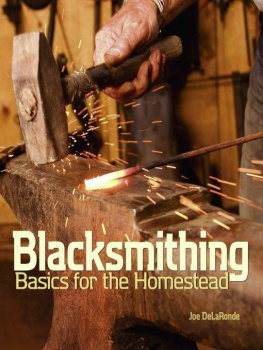Blacksmithing
The Ultimate Blacksmithing Techniques Guide
By Benji Grayhound
Introduction
Most people often misunderstand the art of blacksmithing. Some believe that Blacksmithing is the trade of angry people; that beating and pounding metal is a great way to exercise out your anger and frustration. This, however, is far from true. Blacksmithing is a trade that requires a calm, patient and controlled mind. The essence of the trade is not necessarily strength but patience and perseverance. Anything done in anger will never yield anything beautiful. Anything done in haste is often half regrettable. The secret is to hit the metal with the right amount of force. The art of Blacksmithing possesses an almost Zen-like quality, with its discipline of the mind. Beautiful ironworks is the product of a calculated and clear mind, of patiently waiting as your metals take shape.
This book is written for anyone who has an interest in learning the trade of Blacksmithing. In it, youll find an outlined history of the trade to help you understand its roots and why only a few people know about it now. You will also learn ore about the different tools used in this trade and be educated about the metals used and the primary techniques employed by blacksmiths. There are also practical applications and small projects if ever you wish to fully experience and learn the trade.
Lastly, youll find plenty of beginners tips and vocabulary lists to help you better understand how things work.
I hope that this book would help you a lot in your quest for knowledge about the art of Blacksmithing!

Fast Facts: The Ironbridge in Shropshire, England
Built in 1779, this bridge spans the Severn River and is the world's first iron bridge. This bridge is made from cast iron segments. It is about 100 feet and 6 inches long and took 20 months to build. It has 1700 individual pieces with the largest weighing over 5 tons. Each piece is forged individually to fit with each other.
Chapter 1: History
What is a Blacksmith? The term Blacksmith is a combination of two words: black and smith. Generally, a smith is someone who works with metal. The Iron Age and Blacksmithing came hand in hand. The Iron Age started when a primitive man discovered a faster way to melt iron ore to produce iron. Although lead is naturally common, it was never found in great quantities. Iron, on the other hand, is well distributed around the world. The first sources of iron came from meteorites and iron nodules from bogs and clay banks. Iron, as a, blacksmithing material became widely popular due to the construction of smelters or bloomeries.
Bloomeries were strategically built in areas with an abundant supply of charcoal, iron ores and flux. These Bloomeries are beehive like furnaces built into rocks that can withstand repeated heating. They have a vent on top and another opening on the side. Here, iron deposits were melted or smelted to separate the metal from the rocks. However, smelting iron requires hard work. Not only did they need a large supply of charcoal to fuel the furnaces, they also needed to find an ore that can produce the most amount of iron with the least amount of work. The iron ore was placed inside the furnace and the charcoal contained within was set alight. As the charcoal burned hotter, the iron flowed and formed blooms. These blooms are then taken, hammered and shaped to ingots.

For decades, Blacksmithing remained a crude art. It took years for people to get a grasp of Metallurgy. Blacksmiths experimented on iron to create a more durable metal. They also developed processes to temper and harden the metal. They played with the carbon content of iron to make it more usable. They developed the alloys and the different tool steels that we use today. As the iron industry prospered, so did blacksmithing. Blacksmithing eventually branched out to different specialties. By 1793, Eli Whitney, who was a genius in mass producing metal parts, heralded the Industrial Revolution. He created and patented the cotton gin machine. This machine not only simplified cotton production, it also greatly reduced the cost of cotton. In turn, as the cotton industry prospered, the blacksmiths were called upon to provide the plows to plant cotton, the wheels, and horses shod and build better roads to transport products.
By 1838, John Deere was able to manufacture a superior plow that is made from steel. This single event sparked a significant milestone iron versus steel. This is also introduced the era of steam power. Inside the blacksmiths forges, things changed as well. Bellows were replaced by rotary fan blowers and in larger shops; a steam powered trip hammer was also used. During 1860, lumber was starting to cost less and this made most people want to live in houses instead of log cabins. But as lumber grew cheaper, nails became more expensive. At the time, a single nail is made a piece at a time by a blacksmith. And as the demand grew bigger, people begun to find ways to mass produce nails and make it more affordable. Wheelings LaBelle Nail Co. answered the peoples demands and started producing nails in massive amounts. They manufactured nails and sold it an affordable price. This robbed the blacksmiths of their foremost product.
By the late 1800s, railroads connected the country and hardware is now mass produced in factories and sold in shops. Automobiles came into the picture and as World War I ended, so did wagon making. This further pushed blacksmithing trade close to nonexistence. Some blacksmiths were able to transit from working on wagons to automobiles. The Studebaker Family, well known for their Conestoga wagons, is an example of the ones who made the successful transition.
Although the blacksmithing trade did not disappear overnight it was nearly nonexistent by the 1950s. The trade survived just barely, and only as a specialty. This era, however, was considered the golden age for architectural ironwork. A lot of Americas most precious ironwork was made during this era. The Samuel Yellin Ironworks in Philadelphia was commissioned to create the iron grills for the windows of the Federal Reserve Bank. Some blacksmiths managed by commissioning intricate ironworks for mansions. These commissioned ironwork pieces involved stairs, window grills, gates, door knockers, and chandeliers. Decorative Ironworks, however, came to an end as the Great Depression and the Second World War loomed.
Blacksmiths and Dentistry
Dentistry was established around 19th century. But before that, people who cured dental problems were called Tooth drawers or Tooth Pullers. The term was coined due to the small pliers tooth drawers used to extract tooth. Blacksmith was more associated with this discipline mainly because they are responsible for creating and supplying the pliers that the tooth drawers used.
Chapter 2: Basic Tools
In this chapter, you will be introduced to the blacksmiths workplace and to the different tools that they use. First up is the forge . At the heart of every Blacksmiths workplace is a hearth. This hearth is the forge or the smithy. Some people refer to the workplace as a forge but in reality, the forge is actually the hearth of fire used to heat the metals. Back in the medieval times, charcoal and charcoal residues called coke are primarily used to fuel the forges. Wood is heated hot enough but is deprived of oxygen to leave carbon behind which then produces charcoal. Coke is a byproduct of charcoal that can also be utilized as a forge fuel. Nowadays, gas forges are available and it offers a more convenient substitute to coal forges. Gas forges can heat more small ingots at the same time it thus, however, produces lower heat value compared to charcoal forges. The lower heat requires the ingots to be in the forge longer to melt. The longer heating time risks highly oxidizing the ingot. To avoid unnecessary oxidization, a special kind of flux is added. Charcoal forges are prized for their higher heat value and less oxidation risks.
Next page
